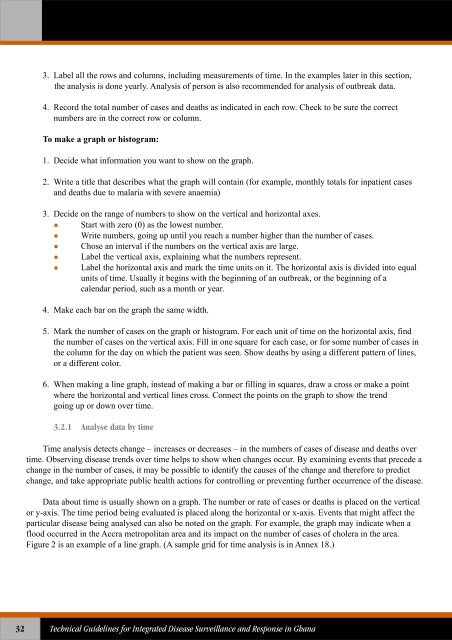Technical Guidelines for Integrated Disease Surveillance ... - PHRplus
Technical Guidelines for Integrated Disease Surveillance ... - PHRplus
Technical Guidelines for Integrated Disease Surveillance ... - PHRplus
Create successful ePaper yourself
Turn your PDF publications into a flip-book with our unique Google optimized e-Paper software.
3. Label all the rows and columns, including measurements of time. In the examples later in this section,the analysis is done yearly. Analysis of person is also recommended <strong>for</strong> analysis of outbreak data.4. Record the total number of cases and deaths as indicated in each row. Check to be sure the correctnumbers are in the correct row or column.To make a graph or histogram:1. Decide what in<strong>for</strong>mation you want to show on the graph.2. Write a title that describes what the graph will contain (<strong>for</strong> example, monthly totals <strong>for</strong> inpatient casesand deaths due to malaria with severe anaemia)3. Decide on the range of numbers to show on the vertical and horizontal axes. Start with zero (0) as the lowest number. Write numbers, going up until you reach a number higher than the number of cases. Chose an interval if the numbers on the vertical axis are large. Label the vertical axis, explaining what the numbers represent. Label the horizontal axis and mark the time units on it. The horizontal axis is divided into equalunits of time. Usually it begins with the beginning of an outbreak, or the beginning of acalendar period, such as a month or year.4. Make each bar on the graph the same width.5. Mark the number of cases on the graph or histogram. For each unit of time on the horizontal axis, findthe number of cases on the vertical axis. Fill in one square <strong>for</strong> each case, or <strong>for</strong> some number of cases inthe column <strong>for</strong> the day on which the patient was seen. Show deaths by using a different pattern of lines,or a different color.6. When making a line graph, instead of making a bar or filling in squares, draw a cross or make a pointwhere the horizontal and vertical lines cross. Connect the points on the graph to show the trendgoing up or down over time.3.2.1 Analyse data by timeTime analysis detects change – increases or decreases – in the numbers of cases of disease and deaths overtime. Observing disease trends over time helps to show when changes occur. By examining events that precede achange in the number of cases, it may be possible to identify the causes of the change and there<strong>for</strong>e to predictchange, and take appropriate public health actions <strong>for</strong> controlling or preventing further occurrence of the disease.Data about time is usually shown on a graph. The number or rate of cases or deaths is placed on the verticalor y-axis. The time period being evaluated is placed along the horizontal or x-axis. Events that might affect theparticular disease being analysed can also be noted on the graph. For example, the graph may indicate when aflood occurred in the Accra metropolitan area and its impact on the number of cases of cholera in the area.Figure 2 is an example of a line graph. (A sample grid <strong>for</strong> time analysis is in Annex 18.)32<strong>Technical</strong> <strong>Guidelines</strong> <strong>for</strong> <strong>Integrated</strong> <strong>Disease</strong> <strong>Surveillance</strong> and Response in Ghana















